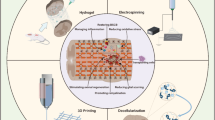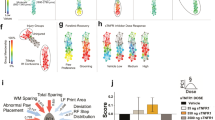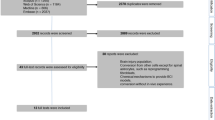Abstract
Study design
Systematic Review
Objectives
To systematically examine the use of bioengineered scaffolds, with/without bioactive agents, drugs, or cellular transplants in preclinical animal models and human studies of spinal cord injury (SCI).
Setting
Sina Trauma and Surgery Research Center, Tehran University of Medical Sciences
Methods
A systematic review and meta-analysis was conducted following PRISMA guidelines and registered in PROSPERO (ID: CRD42023437266). A comprehensive search in MEDLINE and Embase on 8/27/2023 identified studies on scaffolds as neuroregenerative and neuroprotective treatments for SCI. Human studies were assessed using ROBINS-I, and meta-analysis focused on clinical outcomes.
Results
Of 4561 articles screened, 931 studies were included: in-vivo (82%), in-vitro (16%), and human studies (1%). Various biomaterials (N = 82; natural: 38%; synthetic: 62%), cell types (N = 27; NSCs: 24%, Schwann cells: 13%, NPCs: 12%), bioactive agents (N = 38; NT-3: 32%, BDNF: 25%, FGF: 24%), and pharmacological agents (N = 88; chABC: 12%, heparin: 11%, taxels: 10%) were analyzed. Fourteen human studies included acute and chronic SCI patients, with cervical (36%) and thoracic SCI (64%). Clinical trials demonstrated moderate to low quality (ROBINS-I). Our meta-analysis indicated that the pooled 2-scale AIS conversion rate was 30.59% (p = 0.005) ranging from 33.46% (p = 0.036) in acute to 28.35% (p = 0.084) in chronic SCI. Furthermore, the pooled 1-scale AIS conversion rate was 11.79% (p = 0.011), spanning from 17.31% (p = 0.131) in acute to 7.44% (p = 0.081) in chronic SCI.
Conclusion
Scaffold implantation shows promising neuroregenerative potential, evidenced by AIS grade improvement in human studies. Scaffolds are advancing rapidly from laboratory research to clinical trials, expanding treatment options for SCI.
This is a preview of subscription content, access via your institution
Access options
Subscribe to this journal
Receive 12 print issues and online access
$259.00 per year
only $21.58 per issue
Buy this article
- Purchase on SpringerLink
- Instant access to full article PDF
Prices may be subject to local taxes which are calculated during checkout






Similar content being viewed by others
References
Fehlings MG, Tetreault LA, Hachem L, Evaniew N, Ganau M, McKenna SL, et al. An update of a clinical practice guideline for the management of patients with acute spinal cord injury: recommendations on the role and timing of decompressive surgery. Glob Spine J. 2024;14:174S–86S.
Kwon BK, Tetreault LA, Martin AR, Arnold PM, Marco RA, Newcombe VF, et al. A clinical practice guideline for the management of patients with acute spinal cord injury: recommendations on hemodynamic management. Glob Spine J. 2024;14:187S–211S.
Eraifej J, Nnadi C, Ganau M. Early and ultra-early surgical decompression for acute spinal cord injury: bracing for the winds of change. Eur Spine J. 2022;31:1691–2.
Ahuja CS, Wilson JR, Nori S, Kotter MRN, Druschel C, Curt A, et al. Traumatic spinal cord injury. Nat Rev Dis Primers. 2017;3:17018.
Tator CH. Strategies for recovery and regeneration after brain and spinal cord injury. Inj Prev. 2002;8:iv33–iv6.
Patek M, Stewart M. Spinal cord injury. Anaest Intens Care M. 2023;24:406–11.
Hachem LD, Fehlings MG. Pathophysiology of spinal cord injury. Neurosurg Clin. 2021;32:305–13.
Butler DL, Goldstein SA, Guldberg RE, Guo XE, Kamm R, Laurencin CT, et al. The impact of biomechanics in tissue engineering and regenerative medicine. Tissue Eng Part B Rev. 2009;15:477–84.
Chen K, Yu W, Zheng G, Xu Z, Yang C, Wang Y, et al. Biomaterial-based regenerative therapeutic strategies for spinal cord injury. NPG Asia Mater. 2024;16:5.
Lv B, Shen N, Cheng Z, Chen Y, Ding H, Yuan J, et al. Strategies for biomaterial-based spinal cord injury repair via the TLR4-NF-ΚB signaling pathway. Front Bioeng Biotechnol. 2022;9:813169.
Li X, Zhang J, Zhao R, Zhou J, Ying MF, Zhao YZ, et al. Biomaterial scaffolds for delivering neurotrophic factors in spinal cord injury treatment. Available at SSRN 4695200.
Han Q, Sun W, Lin H, Zhao W, Gao Y, Zhao Y, et al. Linear ordered collagen scaffolds loaded with collagen-binding brain-derived neurotrophic factor improve the recovery of spinal cord injury in rats. Tissue Eng Part A. 2009;15:2927–35.
Kourgiantaki A, Tzeranis DS, Karali K, Georgelou K, Bampoula E, Psilodimitrakopoulos S, et al. Neural stem cell delivery via porous collagen scaffolds promotes neuronal differentiation and locomotion recovery in spinal cord injury. NPJ Regen Med. 2020;5:12.
Nguyen LH, Gao M, Lin J, Wu W, Wang J, Chew SY. Three-dimensional aligned nanofibers-hydrogel scaffold for controlled non-viral drug/gene delivery to direct axon regeneration in spinal cord injury treatment. Sci Rep. 2017;7:42212.
Moher D, Liberati A, Tetzlaff J, Altman DG, PRISMA Group* t. Preferred reporting items for systematic reviews and meta-analyses: the PRISMA statement. Ann Intern Med. 2009;151:264–9.
Sterne JA, Hernán MA, Reeves BC, Savović J, Berkman ND, Viswanathan M, et al. ROBINS-I: a tool for assessing risk of bias in non-randomised studies of interventions. BMJ. 2016;355:i4919.
Cheng H, Liao KK, Liao SF, Chuang TY, Shih YH. Spinal cord repair with acidic fibroblast growth factor as a treatment for a patient with chronic paraplegia. Spine. 2004;29:E284–8.
Amr SM, Gouda A, Koptan WT, Galal AA, Abdel-Fattah DS, Rashed LA, et al. Bridging defects in chronic spinal cord injury using peripheral nerve grafts combined with a chitosan-laminin scaffold and enhancing regeneration through them by co-transplantation with bone-marrow-derived mesenchymal stem cells: case series of 14 patients. J Spinal Cord Med. 2014;37:54–71.
Kim KD, Lee KS, Coric D, Chang JJ, Harrop JS, Theodore N, et al. A study of probable benefit of a bioresorbable polymer scaffold for safety and neurological recovery in patients with complete thoracic spinal cord injury: 6-month results from the INSPIRE study. J Neurosurg Spine. 2021;34:808–17.
Kim KD, Lee KS, Coric D, Harrop JS, Theodore N, Toselli RM. Acute implantation of a bioresorbable polymer scaffold in patients with complete thoracic spinal cord injury: 24-month follow-up from the INSPIRE study. Neurosurgery. 2022;90:668–75.
Deng WS, Ma K, Liang B, Liu XY, Xu HY, Zhang J, et al. Collagen scaffold combined with human umbilical cord-mesenchymal stem cells transplantation for acute complete spinal cord injury. Neural Regen Res. 2020;15:1686–700.
Wu JC, Huang WC, Tsai YA, Chen YC, Cheng H. Nerve repair using acidic fibroblast growth factor in human cervical spinal cord injury: a preliminary phase I clinical study. J Neurosurg Spine. 2008;8:208–14.
Tang F, Tang J, Zhao Y, Zhang J, Xiao Z, Chen B, et al. Long-term clinical observation of patients with acute and chronic complete spinal cord injury after transplantation of NeuroRegen scaffold. Sci China Life Sci. 2022;65:909–26.
Ammar AS, Osman Y, Hendam AT, Hasen MA, Al Rubaish FA, Al Nujaidi DY, et al. A method for reconstruction of severely damaged spinal cord using autologous hematopoietic stem cells and platelet-rich protein as a biological scaffold. Asian J Neurosurg. 2017;12:681–90.
Iwatsuki K, Tajima F, Ohnishi Y, Nakamura T, Ishihara M, Hosomi K, et al. A pilot clinical study of olfactory mucosa autograft for chronic complete spinal cord injury. Neurol Med Chir. 2016;56:285–92.
Curcio M, Bradke F. Axon regeneration in the central nervous system: facing the challenges from the inside. Annu Rev Cell Dev Biol. 2018;34:495–521.
Greenhalgh AD, Zarruk JG, Healy LM, Baskar Jesudasan SJ, Jhelum P, Salmon CK, et al. Peripherally derived macrophages modulate microglial function to reduce inflammation after CNS injury. PLoS Biol. 2018;16:e2005264.
Momenzadeh S, Jami M-S. Remyelination in PNS and CNS: current and upcoming cellular and molecular strategies to treat disabling neuropathies. Mol Biol Rep. 2021;48:8097–110.
Hamid OA, Eltaher HM, Sottile V, Yang J. 3D bioprinting of a stem cell-laden, multi-material tubular composite: an approach for spinal cord repair. Mater Sci Eng C Mater Biol Appl. 2021;120:111707.
Xue W, Shi W, Kong Y, Kuss M, Duan B. Anisotropic scaffolds for peripheral nerve and spinal cord regeneration. Bioact Mater. 2021;6:4141–60.
Tian L, Prabhakaran MP, Ramakrishna S. Strategies for regeneration of components of nervous system: scaffolds, cells and biomolecules. Regen Biomater. 2015;2:31–45.
Suzuki H, Imajo Y, Funaba M, Ikeda H, Nishida N, Sakai T. Current concepts of biomaterial scaffolds and regenerative therapy for spinal cord injury. Int J Mol Sci. 2023;24:2528.
Ganau M. Tackling gliomas with nanoformulated antineoplastic drugs: suitability of hyaluronic acid nanoparticles. Clin Transl Oncol. 2014;16:220–3.
Chelyshev YA, Kabdesh IM, Mukhamedshina YO. Extracellular matrix in neural plasticity and regeneration. Cell Mol Neurobiol. 2022;42:647–64.
Grimpe B, Silver J. The extracellular matrix in axon regeneration. Prog Brain Res. 2002;137:333–49.
Liu S, Yu J-M, Gan Y-C, Qiu X-Z, Gao Z-C, Wang H, et al. Biomimetic natural biomaterials for tissue engineering and regenerative medicine: new biosynthesis methods, recent advances, and emerging applications. Mil Med Res. 2023;10:16.
Ashraf R, Sofi HS, Beigh MA, Majeed S, Arjamand S, Sheikh FA. Prospects of natural polymeric scaffolds in peripheral nerve tissue-regeneration. Adv Exp Med Biol. 2018;1077:501–25.
Fan C, Li X, Xiao Z, Zhao Y, Liang H, Wang B, et al. A modified collagen scaffold facilitates endogenous neurogenesis for acute spinal cord injury repair. Acta Biomater. 2017;51:304–16.
Li X, Dai J. Bridging the gap with functional collagen scaffolds: tuning endogenous neural stem cells for severe spinal cord injury repair. Biomater Sci. 2018;6:265–71.
Gunatillake PA, Adhikari R, Gadegaard N. Biodegradable synthetic polymers for tissue engineering. Eur Cell Mater. 2003;5:1–16.
Tang X, Thankappan SK, Lee P, Fard SE, Harmon MD, Tran K, et al. Polymeric biomaterials in tissue engineering and regenerative medicine. Nat Synth Biomed Polym. 2014:351–71. https://www.sciencedirect.com/science/article/abs/pii/B9780123969835000223
Zeller SL, Stein A, Frid I, Carpenter AB, Soldozy S, Rawanduzy C, et al. Critical care of spinal cord injury. Curr Neurol Neurosci Rep. 2024;24:355–63.
Xiao Z, Tang F, Zhao Y, Han G, Yin N, Li X, et al. Significant improvement of acute complete spinal cord injury patients diagnosed by a combined criteria implanted with NeuroRegen scaffolds and mesenchymal stem cells. Cell Transplant. 2018;27:907–15.
Chen W, Zhang Y, Yang S, Sun J, Qiu H, Hu X, et al. NeuroRegen scaffolds combined with autologous bone marrow mononuclear cells for the repair of acute complete spinal cord injury: A 3-year clinical study. Cell Transplant. 2020;29:963689720950637.
Pan Z, Ding J. Poly (lactide-co-glycolide) porous scaffolds for tissue engineering and regenerative medicine. Interface Focus. 2012;2:366–77.
Santhosh KT, Alizadeh A, Karimi-Abdolrezaee S. Design and optimization of PLGA microparticles for controlled and local delivery of Neuregulin-1 in traumatic spinal cord injury. J Control Release. 2017;261:147–62.
Lu Y, Cheng D, Niu B, Wang X, Wu X, Wang A. Properties of poly (lactic-co-glycolic acid) and progress of poly (lactic-co-glycolic acid)-based biodegradable materials in biomedical research. Pharmaceuticals. 2023;16:454.
Zeraatpisheh Z, Mirzaei E, Nami M, Alipour H, Mahdavipour M, Sarkoohi P, et al. Local delivery of fingolimod through PLGA nanoparticles and PuraMatrix‐embedded neural precursor cells promote motor function recovery and tissue repair in spinal cord injury. Eur J Neurosci. 2021;54:5620–37.
Rajabi N, Rezaei A, Kharaziha M, Bakhsheshi-Rad HR, Luo H, RamaKrishna S, et al. Recent advances on bioprinted gelatin methacrylate-based hydrogels for tissue repair. Tissue Eng Part A. 2021;27:679–702.
Kubinová Š, Horak D, Hejčl A, Plichta Z, Kotek J, Sykova E. Highly superporous cholesterol‐modified poly (2‐hydroxyethyl methacrylate) scaffolds for spinal cord injury repair. J Biomed Mater Res A. 2011;99:618–29.
Livingston JM, Gilbert EA, Gao D, Morshead CM Neural stem cells, differentiation, and migration. Neurodevelopmental pediatrics: genetic and environmental influences. Springer; 2023. p. 39–54.
Guo W, Zhang X, Zhai J, Xue J. The roles and applications of neural stem cells in spinal cord injury repair. Front Bioeng Biotechnol. 2022;10:966866.
Xue W, Fan C, Chen B, Zhao Y, Xiao Z, Dai J. Direct neuronal differentiation of neural stem cells for spinal cord injury repair. Stem Cells. 2021;39:1025–32.
Schuh CM, Sandoval-Castellanos AM, De Gregorio C, Contreras-Kallens P, Haycock JW The role of schwann cells in peripheral nerve function, injury, and repair. Cell Eng Regen. 2020:215-36. https://link.springer.com/rwe/10.1007/978-3-319-08831-0_5
Kanno H, Pearse DD, Ozawa H, Itoi E, Bunge MB. Schwann cell transplantation for spinal cord injury repair: its significant therapeutic potential and prospectus. Rev Neurosci. 2015;26:121–8.
Wiliams RR, Bunge MB. Schwann cell transplantation: a repair strategy for spinal cord injury? Prog Brain Res. 2012;201:295–312.
Collins MN, Zamboni F, Serafin A, Escobar A, Stepanian R, Culebras M, et al. Emerging scaffold-and cellular-based strategies for brain tissue regeneration and imaging. In Vitro Model. 2022;1:129–50.
Keefe KM, Sheikh IS, Smith GM. Targeting neurotrophins to specific populations of neurons: NGF, BDNF, and NT-3 and their relevance for treatment of spinal cord injury. Int J Mol Sci. 2017;18:548.
Chen T, He X, Wang J, Du D, Xu Y. NT-3 combined with TGF-β signaling pathway enhance the repair of spinal cord injury by inhibiting glial scar formation and promoting axonal regeneration. Mol Biotechnol. 2024;66:1484–95.
Cong Y, Wang C, Wang J, Li H, Li Q. NT-3 promotes oligodendrocyte proliferation and nerve function recovery after spinal cord injury by inhibiting autophagy pathway. J Surg Res. 2020;247:128–35.
Hanna A, Thompson DL, Hellenbrand DJ, Lee JS, Madura CJ, Wesley MG, et al. Sustained release of neurotrophin‐3 via calcium phosphate‐coated sutures promotes axonal regeneration after spinal cord injury. J Neurosci Res. 2016;94:645–52.
Garraway SM, Huie JR. Spinal plasticity and behavior: BDNF‐induced neuromodulation in uninjured and injured spinal cord. Neural Plast. 2016;2016:9857201.
He J, Cai H, Wang Y, Yan J, Fan C. Matrix-metalloproteinase-responsive brain-derived neurotrophic factor for spinal cord injury repair. Processes. 2024;12:1510.
Shamsnia HS, Peyrovinasab A, Amirlou D, Sirouskabiri S, Rostamian F, Basiri N, et al. BDNF-TrkB signaling pathway in spinal cord injury: insights and implications. Mol Neurobiol. 2024;62:1904–44.
Poorirani S, Taheri SL, Mostafavi SA. Scaffolds: a biomaterial engineering in targeted drug delivery for osteoporosis. Osteoporos Int. 2023;34:255–67.
Barritt A, Davies M, Marchand F, Hartley R, Grist J, Yip P, et al. Chondroitinase ABC promotes sprouting of intact and injured spinal systems after spinal cord injury. J Neurosci. 2006;26:10856–67.
Khalil AS, Hellenbrand D, Reichl K, Umhoefer J, Filipp M, Choe J, et al. A localized materials‐based strategy to non‐virally deliver chondroitinase ABC mRNA improves hindlimb function in a rat spinal cord injury model. Adv Healthc Mater. 2022;11:2200206.
Ito S, Ozaki T, Morozumi M, Imagama S, Kadomatsu K, Sakamoto K. Enoxaparin promotes functional recovery after spinal cord injury by antagonizing PTPRσ. Exp Neurol. 2021;340:113679.
Deng W-S, Yang K, Liang B, Liu Y-F, Chen X-Y, Zhang S. Collagen/heparin sulfate scaffold combined with mesenchymal stem cells treatment for canines with spinal cord injury: a pilot feasibility study. J Orthop Surg. 2021;29:23094990211012293.
Li Z, Zhou T, Bao Z, Wu M, Mao Y. The porous SilMA hydrogel scaffolds carrying dual-sensitive paclitaxel nanoparticles promote neuronal differentiation for spinal cord injury repair. Tissue Eng Regen Med. 2024;21:809–27.
Wang Y, Lv H-Q, Chao X, Xu W-X, Liu Y, Ling G-X, et al. Multimodal therapy strategies based on hydrogels for the repair of spinal cord injury. Mil Med Res. 2022;9:16.
Sultan I, Lamba N, Liew A, Doung P, Tewarie I, Amamoo JJ, et al. The safety and efficacy of steroid treatment for acute spinal cord injury: a systematic review and meta-analysis. Heliyon. 2020;6:e03414.
Mueller G, Berlowitz DJ, Raab AM, Postma K, Gobets D, Huber B, et al. Incidence and risk factors of pneumonia in individuals with acute spinal cord injury: a multi-national, multi-center, prospective cohort study. Arch Phys Med Rehabil. 2024;105:884–91.
Moradi S, Mahdizadeh H, Šarić T, Kim J, Harati J, Shahsavarani H, et al. Research and therapy with induced pluripotent stem cells (iPSCs): social, legal, and ethical considerations. Stem Cell Res Ther. 2019;10:341.
Chehelgerdi M, Behdarvand Dehkordi F, Chehelgerdi M, Kabiri H, Salehian-Dehkordi H, Abdolvand M, et al. Exploring the promising potential of induced pluripotent stem cells in cancer research and therapy. Mol Cancer. 2023;22:189.
Sugai K, Sumida M, Shofuda T, Yamaguchi R, Tamura T, Kohzuki T, et al. First-in-human clinical trial of transplantation of iPSC-derived NS/PCs in subacute complete spinal cord injury: study protocol. Regen Ther. 2021;18:321–33.
Zhao Y, Tang F, Xiao Z, Han G, Wang N, Yin N, et al. Clinical study of NeuroRegen scaffold combined with human mesenchymal stem cells for the repair of chronic complete spinal cord injury. Cell Transplant. 2017;26:891–900.
Theodore N, Hlubek R, Danielson J, Neff K, Vaickus L, Ulich TR, et al. First human implantation of a bioresorbable polymer scaffold for acute traumatic spinal cord injury: a clinical pilot study for safety and feasibility. Neurosurgery. 2016;79:E305–12.
Xiao Z, Tang F, Tang J, Yang H, Zhao Y, Chen B, et al. One-year clinical study of NeuroRegen scaffold implantation following scar resection in complete chronic spinal cord injury patients. Sci China Life Sci. 2016;59:647–55.
Acknowledgements
M.G.’s contribution to this article was made in the context of the Oxford Global Neurosurgery Initiative.
Author information
Authors and Affiliations
Contributions
AKh and NS conducted independent screenings of the titles and abstracts to assess eligibility, with ZR providing final approval in cases of discrepancies. Data extraction was performed independently by three pairs: EKh and MH, MM and KR, and ME and AE, with TM consulted for final approval in cases of discrepancies. AKh and MS performed data analysis and visualization. AKh wrote the manuscript, while AKh, MS, and ZH contributed to the conceptualization of the study. Supervision was provided by MGF, MG, ASH, and MS Project administration was led by MS. All authors reviewed and provided critical feedback on the manuscript.
Corresponding author
Ethics declarations
Competing interests
(Dr. Michael Fehlings as Editor-in-Chief of Spinal Cord had no role in the peer review or adjudication of this manuscript).
Ethical consideration
This study was reviewed and approved by the Ethics Committee of Tehran University of Medical Sciences, with the approval code.
Additional information
Publisher’s note Springer Nature remains neutral with regard to jurisdictional claims in published maps and institutional affiliations.
Supplementary information
Rights and permissions
Springer Nature or its licensor (e.g. a society or other partner) holds exclusive rights to this article under a publishing agreement with the author(s) or other rightsholder(s); author self-archiving of the accepted manuscript version of this article is solely governed by the terms of such publishing agreement and applicable law.
About this article
Cite this article
Khavandegar, A., Safari Dehnavi, N., Ganau, M. et al. Neuroregenerative and neuroprotective effects of bioengineered scaffolds in spinal cord injury: a systematic review of preclinical and early phase clinical studies. Spinal Cord 63, 451–469 (2025). https://doi.org/10.1038/s41393-025-01114-9
Received:
Revised:
Accepted:
Published:
Issue date:
DOI: https://doi.org/10.1038/s41393-025-01114-9



